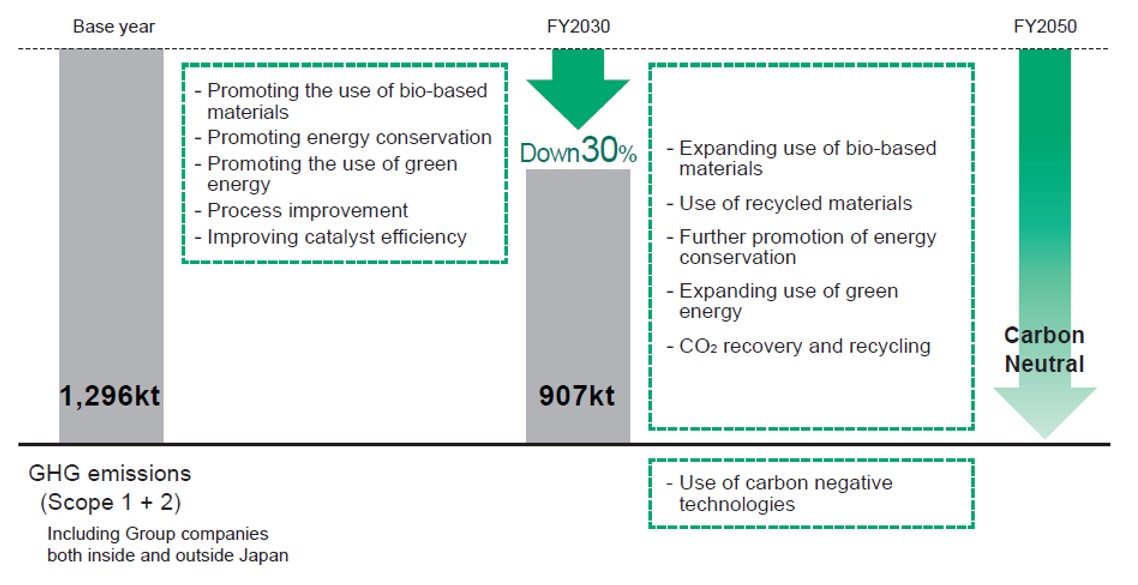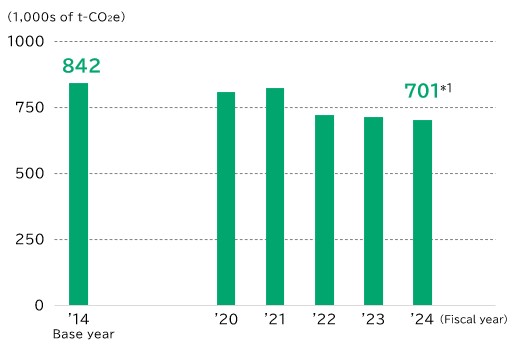Tackling Climate Change
Click here for the TCFD report.
Promoting Greenhouse Gas (GHG) Emissions Reduction
Formulating a roadmap for reducing GHG emissions
Nippon Shokubai formulated a roadmap for reducing GHG emissions by 2050 in terms of the “strategic transformation for environmental initiatives,” one of the “three transformations” set out in “TechnoAmenity for the future,” the Nippon Shokubai Group long-term vision published in April 2021.
In conjunction with the development of the company’s Medium-term Management Plan announced in April 2025, we have identified materiality and newly established Group-wide goals for reducing GHG emissions (Scope 1+2), including those of the group companies outside Japan.
By 2030, we will reduce GHG emissions through measures centering on the promotion of energy conservation with manufacturing process improvements, the use of green energy, the partially replacing raw materials with biomass, and the improvement of catalyst efficiency.
From 2030 to 2050, we will promote the above measures and reduce energy-origin GHG emissions by promoting green fuels, such as hydrogen and ammonia. Additionally, we plan to reduce non-energy-origin GHG emissions by expanding the use of biomass and recycled raw materials and by using carbon recycling technology (carbon dioxide capture, utilization, and storage).
Roadmap for Reducing GHG Emissions by 2050

Reducing energy consumption and CO2 emissions
Our RC Promotion Committee, which is chaired by the Company President, formulated a Medium-Term RC Basic Plan based on the targets set out in the action plan of the Japan Chemical Industry Association (JCIA) for achieving a low carbon society. On the basis of this plan, each of our plants takes action to mitigate climate change under the leadership of the committees responsible for promoting energy conservation activities and a reduction in CO2 emissions.
In FY2024, energy-saving activities progressed, and the energy consumption intensity improved due to an increase in the production volume of energy generation products. In addition, CO2 emissions decreased as a result of continued use of carbon offset city gas (formerly carbon-neutral city gas) and improvement in CO2 emission intensity. Our domestic GHG emissions in FY2024 were 701 thousand tons-CO2e*¹, representing a 16.8%*¹ reduction compared to FY2014.
Since FY2021, we have been generating solar power (on-site PPA) at the Himeji Plant. In addition, we promote energy conservation activities through the collection of waste heat and the introduction of a co-generation system. We also collect part of the CO2 generated in the manufacturing process and sell it as liquefied carbon dioxide to reduce CO2 emissions.
The calculation of GHG emissions and energy consumption has undergone third-party verification (see Third-party Verification Report on GHG).
*1 Including a carbon credit offset of 58,000 tons of CO2 emissions (6.9% reduction from the FY2014 level) due to the purchase of carbon offset city gas.
Trend in GHG Emissions (in Japan)

Employee’s Voice
Energy saving through distillation column modification
The department I belong to manufactures N-Vinylpyrrolidone (NVP). In the NVP manufacturing process, after synthesizing the intermediate N-(2-Hydroxyethyl)-2-pyrrolidone (HEP), the by-product water is recovered in the distillation column and reused in the preceding reaction. However, the distillate contains many high-boiling impurities other than water, and most of the recovered water had to be incinerated as wastewater. This increased fuel consumption for incineration and raised concerns about carbon dioxide emissions from combustion.

1st Production Section
Kawasaki Plant
To reduce the amount of wastewater, impurities in the distillate must be reduced. Upon investigation, we found that the upper temperature in the distillation column was higher than the expected temperature, and appropriate operating conditions were not being maintained. Therefore, in cooperation with the Technology Department, we analyzed the relationship between the temperature inside the distillation column and the amount of impurities in the distillate using computer simulations based on accumulated data from previous manufacturing processes. We identified the malfunctioning parts of the distillation column and proceeded with modification work to improve it.
The challenging part was that the modification work had to be carried out between NVP production runs. I coordinated with related departments within the company, created modification plans, revised production plans, prepared operation schedules, and supervised the construction.
After the modification, the distillate with reduced impurities is now being recycled as raw water. The elimination of wastewater incineration has reduced city gas consumption, achieving energy savings equivalent to 67.9 kiloliters of crude oil annually. Additionally, carbon dioxide emissions from combustion have been reduced by 134 tons annually.
Through this improvement activity, I have re-recognized the importance of reviewing equipment design and operating conditions. I will continue to aim to completely avoid accidents and injuries and ensure stable operation of the plant. Additionally, we will strive to identify and eliminate waste, unevenness, and overburden, and pursue optimal plant operation.
Fluorocarbon emission control
The Act on Rational Use and Proper Management of Fluorocarbons, which covers the entire lifecycle of fluorocarbons from production to disposal, went into effect in April 2015, and regulations for disposing of certain equipment were further tightened in April 2020.
As a manager of Class I specified products, the Company conducts the legally mandated simple inspections and routine inspections according to plans. Additionally, our calculations of leaked fluorocarbons in FY2024 revealed leakage of 144 t-CO2e from the Himeji Plant, 2,684 t-CO2e from the Kawasaki Plant, and 2,931 t-CO2e Company-wide. We intend to make efforts to reduce leaked fluorocarbons—an activity that facilitates climate change mitigation—by intensifying inspections and maintenance, upgrading to equipment that uses coolants with low global warming and ozone depletion potential, and properly disposing of equipment.
Calculations of Leaked Fluorocarbons in FY2024
| Himeji Plant | Kawasaki Plant | Others | Entire company |
|---|---|---|---|
| 144 | 2,684 | 102 | 2,931 |
Promoting Reduction of GHG Emissions Resulting from Our Entire Supply Chain
Calculating Scope 3 emissions
The GHG Protocol classifies GHG emissions into three classes: Scope 1, Scope 2, and Scope 3, which are the total GHG emissions attributable to business activities throughout supply chains for all categories.
- Scope 1Direct GHG emissions by the reporting company itself (e.g. fuel combustion, industrial process)
- Scope 2Indirect emissions from the use of electricity, heat, or steam supplied by others
- Scope 3Indirect emissions other than Scope 1 and Scope 2 (emissions by others related to the company’s activities)
Nippon Shokubai will continue to calculate Scope 3 emissions and explore the possibility of reducing GHG emissions resulting from all corporate activities.
Trend in Scope 3 Emissions (Data for Nippon Shokubai alone)
| No. | Category | Emissions | ||
|---|---|---|---|---|
| FY2022 | FY2023 | FY2024 | ||
| 1 | Purchased goods and services | 1,370 | 1,462 | 1,408 |
| 2 | Capital goods | 43 | 49 | 88 |
| 3 | Fuel- and energy-related activities not included in Scope 1 or Scope 2 | 89 | 97 | 95 |
| 4 | Upstream transportation and distribution | 13 | 14 | 14 |
| 5 | Waste generated in operations | 5 | 5 | 4 |
| 6 | Business travel | 0.3 | 0.3 | 0.3 |
| 7 | Employee commuting | 0.9 | 0.9 | 0.9 |
| 12 | End-of-life treatment of sold products | 1,884 | 1,798 | 1,811 |
| Total | 3,405 | 3,426 | 3,421 | |
Initiatives for the reduction of Scope 3 emissions
In order to contribute to the reduction of Scope 3 emissions, the following items will also be strongly promoted.
- Development and expansion of Environmental Contribution Products (products that contribute to the reduction of CO2 emissions when used, etc.)
- Development and dissemination of CO2 recovery and recycling technology (carbon recycling technology)
- Development and social implementation of material recycling and chemical recycling
Internal Carbon Pricing (ICP)
We have implemented internal carbon pricing (ICP) to promote low carbonization/decarbonization in corporate management on February 1, 2023.
In utilizing the ICP, we will raise awareness of Group’s commitment to decarbonization, promoting energy saving, and activate discussion about opportunities/risks concerning CO2 emission reductions.
This system is accelerating “Strategic Transformation for Environmental Initiatives” of our “three transformations” set forth in our long-term vision.
| ICP | ¥10,000/t-CO2 Shadow price set with reference to domestic and international carbon prices. |
| Method of application | The costs will be calculated using ICP based on a change of CO2 emissions and used as a criterion for investment decision. |
| Range of application | Nippon Shokubai Group |
| GHG Scope | Scope 1+2 |